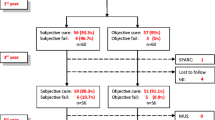Abstract
Purpose
To evaluate long-term (over 4 years) functional outcomes and quality of life of transobturator (TOR) and retropubic (RPR) routes in the cure of stress urinary incontinence (SUI).
Methods
Prospective, randomized multicentre study involving 88 women with SUI from March 2004 to May 2005 (RPR group (n = 42), TOR group (n = 46)). Long-term functional results and quality of life were evaluated using validated questionnaires and compared with those observed at the first year.
Results
Eight patients (19%) in the RPR group and 9 patients (19.5%) in the TOR group were lost to follow-up (NS). The mean follow-up in the RPR and the TOR groups was 52.7 months and 53.1 months, respectively. In intention to treat, the success rate at 4 years was 64.3% in the RPR group and 69.5% in the TOR group (NS). At 4 years, no significant differences in the IIQ scores were observed in either group compared to the preoperative scores with no difference between the groups (RPR group: 32 vs. 14.9 (NS), TOR group: 25.7 vs. 21.4 (NS)). Compared to 1 year UDIQ and IIQ scores, a decrease in quality of life was observed for both groups at 4 years (RPR group: 4.7 vs. 34 (P < 0.0001) and 2.6 vs. 14.9 (P < 0.001), TOR group: 1.2 vs. 38.7 (P < 0.0001) and 0 vs. 21.4 (P < 0.0001)) without difference between the groups.
Conclusions
This study shows similar relatively high long-term success rates for both the RPR and TOR procedures. Patients should be informed about a possible time-dependent alteration in functional results.
Similar content being viewed by others
References
Ulmsten U, Henriksson L, Johnson P, Varhos G (1996) An ambulatory surgical procedure under local anesthesia for treatment of female urinary incontinence. Int Urogynecol J Pelvic Floor Dysfunct 7:81–85 (discussion 85–86)
Delorme E (2001) Transobturator urethral suspension: mini-invasive procedure in the treatment of stress urinary incontinence in women. Prog Urol 11:1306–1313
Fischer A, Fink T, Zachmann S, Eickenbusch U (2005) Comparison of retropubic and outside-in transoburator sling systems for the cure of female genuine stress urinary incontinence. Eur Urol 48:799–804
Latthe PM (2008) Review of transobturator and retropubic tape procedures for stress urinary incontinence. Curr Opin Obstet Gynecol 20:331–336
Porena M, Costantini E, Frea B et al (2007) Tension-free vaginal tape versus transobturator tape as surgery for stress urinary incontinence: results of a multicentre randomised trial. Eur Urol 52:1481–1490
Rechberger T, Futyma K, Jankiewicz K, Adamiak A, Skorupski P (2009) The clinical effectiveness of retropubic (IVS-02) and transobturator (IVS-04) midurethral slings: randomized trial. Eur Urol 56:24–30
Zullo MA, Plotti F, Calcagno M et al (2007) One-year follow-up of tension-free vaginal tape (TVT) and trans-obturator suburethral tape from inside to outside (TVT-O) for surgical treatment of female stress urinary incontinence: a prospective randomised trial. Eur Urol 51:1376–1382 (discussion 1383–1374)
Latthe PM, Foon R, Toozs-Hobson P (2007) Transobturator and retropubic tape procedures in stress urinary incontinence: a systematic review and meta-analysis of effectiveness and complications. Bjog 114:522–531
Assessment, treatment of urinary incontinence (2000) Scientific committee of the first international consultation on incontinence. Lancet 355:2153–2158
Shumaker SA, Wyman JF, Uebersax JS, McClish D, Fantl JA (1994) Health-related quality of life measures for women with urinary incontinence: the incontinence impact questionnaire and the urogenital distress inventory. Continence program in women (CPW) research group. Qual Life Res 3:291–306
David-Montefiore E, Frobert JL, Grisard-Anaf M et al (2006) Peri-operative complications and pain after the suburethral sling procedure for urinary stress incontinence: a French prospective randomised multicentre study comparing the retropubic and transobturator routes. Eur Urol 49:133–138
Ogah J, Cody JD, Rogerson L (2009) Minimally invasive synthetic suburethral sling operations for stress urinary incontinence in women. Cochrane Database Syst Rev 4:CD006375
Doo CK, Hong B, Chung BJ et al (2006) Five-year outcomes of the tension-free vaginal tape procedure for treatment of female stress urinary incontinence. Eur Urol 50:333–338
Krauth JS, Rasoamiaramanana H, Barletta H et al (2005) Sub-urethral tape treatment of female urinary incontinence–morbidity assessment of the trans-obturator route and a new tape (I-STOP): a multi-centre experiment involving 604 cases. Eur Urol 47:102–106 (discussion 106–107)
Meschia M, Pifarotti P, Bernasconi F et al (2001) Tension-Free vaginal tape: analysis of outcomes and complications in 404 stress incontinent women. Int Urogynecol J Pelvic Floor Dysfunct 12:S24–S27
Hsiao SM, Sheu BC, Lin HH (2008) Sequential assessment of urodynamic findings before and after transobturator tape procedure for female urodynamic stress incontinence. Int Urogynecol J Pelvic Floor Dysfunct 19:627–632
Houwert RM, Venema PL, Aquarius AE, Bruinse HW, Roovers JP, Vervest HA (2009) Risk factors for failure of retropubic and transobturator midurethral slings. Am J Obstet Gynecol 201:202 e201–208
Barber MD, Kleeman S, Karram MM et al (2008) Transobturator tape compared with tension-free vaginal tape for the treatment of stress urinary incontinence: a randomized controlled trial. Obstet Gynecol 111:611–621
Darai E, Frobert JL, Grisard-Anaf M et al (2007) Functional results after the suburethral sling procedure for urinary stress incontinence: a prospective randomized multicentre study comparing the retropubic and transobturator routes. Eur Urol 51:795–801 (discussion 801–792)
Costa P, Delmas V (2004) Trans-obturator-tape procedure—“inside out or outside in”: current concepts and evidence base. Curr Opin Urol 14:313–315
Delmas V (2005) Anatomical risks of transobturator suburethral tape in the treatment of female stress urinary incontinence. Eur Urol 48:793–798
Abdel-Fattah M, Ramsay I, Pringle S, Hardwick C, Ali H, Young D, Mostafa A (2010) Randomised prospective single-blinded study comparing ‘inside-out’ versus ‘outside-in’ transobturator tapes in the management of urodynamic stress incontinence: 1 year outcomes from the E-TOT study. BJOG 117:870–878
Conflict of interest
All authors confirm that they have no conflict of interest.
Author information
Authors and Affiliations
Corresponding author
Rights and permissions
About this article
Cite this article
Ballester, M., Bui, C., Frobert, JL. et al. Four-year functional results of the suburethral sling procedure for stress urinary incontinence: a French prospective randomized multicentre study comparing the retropubic and transobturator routes. World J Urol 30, 117–122 (2012). https://doi.org/10.1007/s00345-011-0668-1
Received:
Accepted:
Published:
Issue Date:
DOI: https://doi.org/10.1007/s00345-011-0668-1




